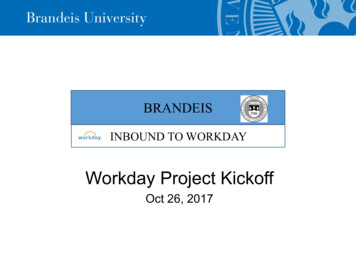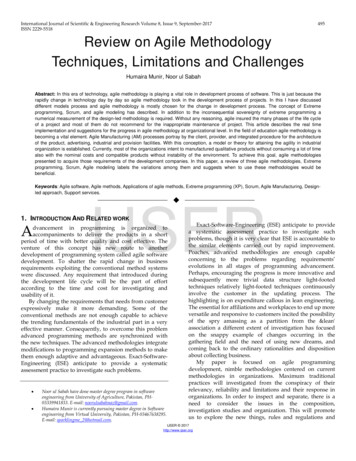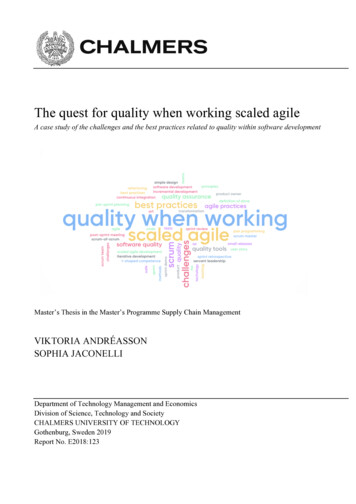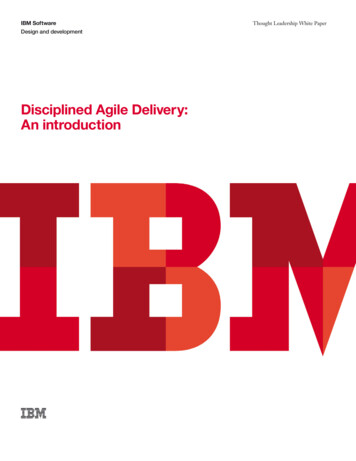
Transcription
4Acquisition & Management Concernsfor Agile Use in Government SeriesAgile Acquisition andMilestone Reviews
Acquisition & Management Concernsfor Agile Use in GovernmentThis booklet is part of a series based on material originally published in a 2011report titled Agile Methods: Selected DoD Management and Acquisition Concerns(CMU/SEI-2011-TN-002).The material has been slightly updated and modified for stand-alone publication.Booklet 1: Agile Development and DoD AcquisitionsBooklet 2: Agile Culture in the DoDBooklet 3: Management and Contracting Practices for Agile ProgramsBooklet 4: Agile Acquisition and Milestone ReviewsBooklet 5: Estimating in Agile AcquisitionBooklet 6: Adopting Agile in DoD IT Acquisitions
Agile Acquisition and Milestone ReviewsThe DoD 5000 series provides the framework for acquiring systems. Thisframework includes a series of technical reviews including but not limited to SystemRequirements Review (SRR), System Design Review (SDR), Software SpecificationReview (SSR), Preliminary Design Review (PDR), and Critical Design Review (CDR)among others. Historically, documents such as MIL-STD-1521, Technical Reviewsand Audits for Systems, Equipment, and Computer Software, or the United StatesAir Force Weapon Systems Software Management Guidebook are used as guidancefor conducting these reviews.1 Some smaller programs do not require this levelof review; however, programs that do require them expect a certain level ofdocumentation and rigor regardless of the development methodology employed.These milestone reviews are system reviews. From a systems point of view, somewould say these reviews are not part of software development methodology and thatthis is an incorrect use of the terms. For purposes of this report and in the viewof the authors, software intensive systems typically are subjected to PDRs, CDRs,and other reviews. While the overall system may be a plane, tank, ship, or satellite,the software still must pass the PDR, CDR, and other milestones. If the system inquestion is an IT system, then the PDR, CDR, and other reviews apply directly, assoftware is the main component of the system (along with hardware to run it on).This booklet is aimed at readers who are contemplating using Agile methods andwho are subject to the typical review activities prevalent in DoD acquisitions. Theauthors hope that this booklet will provide some useful guidance on how to approachAgile methods when following traditional technical milestones.Milestone Review IssueIn the SEI report Considerations for Using Agile in DoD Acquisition, the authors stated:“A very specific acquisition issue and sticking point is that Agile methodology doesnot accommodate large capstone events such as Critical Design Review (CDR), whichis usually a major, multi-day event with many smaller technical meetings leadingup to it. This approach requires a great deal of documentation and many technicalreviews by the contractor” [Lapham 2010]. The types of documentation expectedat these milestone events are considered high ritual and are not typically producedwhen using Agile.2 If the PMO intends to embrace Agile methods then it will needto determine how to meet the standard milestone criteria for the major milestonesreviews, particularly SRR, SDR, PDR, and CDR. However, Agile can be adapted withinmany different types of systems. One of our reviewers said that “the Atlas V heavylaunch guidance system is produced using eXtreme Programming and1Note that this booklet does not address the major milestone decision points, i.e., Milestone A, B, orC. Only technical milestones are addressed here.2“High ritual” is a term used within the Agile community often interchangeably with “high ceremony.”Alistair Cockburn defined ceremony as the amount of precision and the tightness of tolerance in themethodology [Cockburn 2007]. For instance, plan-driven methods such as waterfall are consideredhigh ritual or ceremony as they require an extensive amount of documentation and control. Agilemethods are generally considered low ritual as the amount of documentation and control should be“just enough” for the situation.SOFTWARE ENGINEERING INSTITUTE1
has all the DoD procurement program events.” The key here is knowing how long orhow much effort is required to review the program in question (an hour or a week).In addition, according to one of our reviewers who has monitored Agile-based projectsfrom a government perspective:[I] found that in projects using an Agile methodology, technical reviewsare around delivery of major capabilities and/or leadership is invited tocertain sprint reviews. [I] also found that technical reviews are not asneeded as much because stakeholders buy-in to stories/development/schedule at the end of every sprint, which we found is more productivethan large reviews every so often.In order to determine the type of criteria needed for any review, the intent of thereview or purpose must be known. This raises a question: What is the purpose of anytechnical milestone review?Intent of Technical Milestone ReviewsThe Defense Acquisition Guidebook (DAG) says,Technical Assessment activities measure technical progress andassess both program plans and requirements. Activities within TechnicalAssessment include the conduct of Technical Reviews (includingPreliminary Design Review/Critical Design Review Reports) A structuredtechnical review process should demonstrate and confirm completion ofrequired accomplishments and exit criteria as defined in program andsystem planning . Technical reviews are an important oversight toolthat the program manager can use to review and evaluate the state ofthe system and the program, redirecting activity if necessary. [DefenseAcquisition University 2011a]From a software perspective, each of these reviews is used to evaluate progresson and/or review specific aspects of the proposed technical software solution.Thus, expectations and criteria need to be created that reflect the level and type ofdocumentation that would be acceptable for those milestones and yet work within anAgile environment.ChallengesThe intent of any technical milestone review is for evaluation of progress and/ortechnical solution. For PMOs trained and experienced in the traditional acquisitionmethods, evaluating program progress and technical solutions follows wellestablished guidelines and regulations. Very specific documentation is produced toprovide the data required to meet the intent of the technical review as called outin the program specific Contract Data Requirements List (CDRL). The content ofthese documents and the entry and exit criteria for each review is well documented.However, even in traditional acquisitions (using traditional methods), thesedocuments, exit and entry criteria can be and usually are tailored for the specificprogram. Since the documentation output from Agile methods appears to be “light”2AGILE ACQUISITION AND MILESTONE REVIEWS
in comparison to traditional programs, the tailoring aspects take on additionalaspects. Some of the specific challenges for Agile adoption that we observed duringour interviews that must be addressed are incentives to collaborate shared understanding of definitions/key concepts document content—the look and feel may be different but the intent is the same regulatory languageMany of these challenges are not specific to adopting Agile in DoD acquisitions butare also common to other incremental development approaches such as RationalUnified Process (RUP). In fact, RUP does address this level of milestone review.The reviews are called Lifecycle Architecture (LCA) Review and Lifecycle Objectives(LCO) Review. Some potential solutions to these challenges for Agile adoption arediscussed in the following sections.Agile Success Depends on Tackling ChallengesThe PMO that is adopting or thinking of adopting Agile for an acquisition must setthe stage to allow for the necessary collaboration required between the PMO andother government stakeholders and between the PMO and the contractor(s). Theintroduction of Agile into DoD acquisition can be considered yet another type ofacquisition reform. The Defense Science Board has provided some cautionary wordson any novel approaches for acquiring IT:With so many prior acquisition reform efforts to leverage, any novelapproach for acquiring IT is unlikely to have meaningful impact unlessit addresses the barriers that prevented prior reform efforts from takingroot. Perhaps the two most important barriers to address are experiencedproven leadership and incentives (or lack thereof) to alter the behaviorof individuals and organizations. According to the Defense AcquisitionPerformance Assessment Panel, ‘ current governance structure doesnot promote program success — actually, programs advance in spite of theoversight process rather than because of it.’ This sentiment was echoedby a defense agency director in characterizing IT acquisition as hamperedby the oversight organizations with little “skin in the Game.” [DefenseScience Board 2009]Incentives for Acquirers and Contractors to CollaborateWhile this topic is relevant to all contracting issues, it is particularly important if the“world of traditional milestone review” collides with the “world of agile development.”The authors have observed programs where collaboration was not yet optimal,which resulted in major avoidable issues when milestone review occurred. Thus, weemphasize them here.We take the comment “skin in the game” to mean that the parties involved mustcollaborate. Thus, some form of incentive to do so must be created. (As the DefenseSOFTWARE ENGINEERING INSTITUTE3
Science Board noted, “the two most important barriers are leadership and incentivesor lack thereof.”). It is key that leadership convey clear goals, objectives, and visionfor people to create internal group collaboration and move toward success. One ofour interviewees likened an Agile program to a group of technical climbers goingup a mountain: you are all roped together and if one of you falls, you all fall. If theAgile project is thought of in these terms, it is quite easy to have an incentive tocollaborate. The key for DoD programs is to determine some incentive for bothcontractor and government personnel that is as imperative as the life and deathone is for technical climbers.Incentives need to be team based, not individual based. Agile incentives need to crossgovernment and contractor boundaries as much as is practical, given regulationsthat must be followed. Each individual program has a specific environment andcorresponding constraints. Even with the typical constraints, the successful programswe interviewed had a program identity, which crossed the contractor–governmentboundary. The incentives to collaborate were ingrained in the team culture withrewards being simple things like lunches or group gatherings for peer recognition.It is incumbent upon the PMO and the contractor to negotiate the appropriateincentives to encourage their teams to collaborate. This negotiation needs toconsider all the stakeholders that must participate during the product’s lifecycle,including external stakeholders. The external stakeholders (i.e., special reviewpanels, other programs that interface with the program, senior leadership in theCommand and OSD, etc.) need to be trained so they understand the methods beingused, including, but not limited to, types of artifacts that are produced and how theyrelate to typical program artifacts. Without specific training, serious roadblocks toprogram progress can occur. Buy-in occurs with understanding and knowledge ofAgile and the value it can bring. Defense Acquisition University (DAU) is beginning toprovide some training on Agile methods and the associated acquisition processes.Incentives should not be limited to just the contractor team but also encouraged forthe government team as well. Government teams are often incented to grow theirprograms and follow the regulations. However, these actions should not be incentedin an Agile environment unless the users’ needs are met first.The type of contract could also play into the incentive issue. One of the intervieweesusing a T&M contract stated that they had a limited structure for rewards mainly due tothe structure of the contract, which provided limited motivation for the contracting company to provide rewards as the contract personnel were relegated to the role of bodyshop. With this said, we observed a very collaborative environment on this program.In order to collaborate, all the parties must have a common understanding ofterms and key concepts. According to Alan Shalloway, Agile “has to be cooperative[in] nature and [people] are not going to be convinced if they don’t want to [be]”[Shalloway 2009]. We addressed a set of Agile and DoD terms for which commonunderstanding is required in Section 2.3.1 of the original Tech Note from which thisbooklet is drawn. Some additional key concepts specific to supporting technicalreviews in an Agile setting are discussed in the following sections.4AGILE ACQUISITION AND MILESTONE REVIEWS
Shared Understanding of Definitions/Key ConceptsWhile there are numerous key concepts involved with Agile development methods,the two we heard most about during our interviews were type and amount ofdocumentation and technical reviews.One of the key concepts related to Agile is the type and amount of documentationthat is produced. Typically, Agile teams produce just enough documentation to allowthe team to move forward. Regulatory documentation is still completed and may bedone in a variety of ways. In our interviews, we saw several different approaches toproducing regulatory documentation that was not considered to contribute directlyto the development activities, but will be needed in the future (user manuals,maintenance data) or to meet programmatic requirements: A SETA contractor was hired by the program office to review the repository ofdevelopment information (embedded in a tool that supported Agile methods) andproduce required documentation from it. Technical writers embedded with the Agile team produced documentation in parallelwith the development activities. Contractor personnel doing program controls activities produced requireddocumentation toward the end of each release. The contractor program controlpersonnel took the outputs from the Agile process and formatted them to meet the5000 required documents.Note that if the documentation is not of any value to the overall product or program,then waivers should be sought to eliminate the need.Another key concept is that the whole point of using Agile is to reduce risk by definingthe highest value functions to be demonstrated as early as possible. This meansthat technical reviews like PDR and CDR will be used to validate early versions ofworking software and to review whatever documentation had been agreed to in theacquisition strategy. Thus, additional documentation would not be created just tomeet the traditional set of documents since that set would be tailored a priori.Addressing Expected Document Content MismatchAs previously cited Defense Acquisition Guidebook explains, “A structuredtechnical review process should demonstrate and confirm completion of requiredaccomplishments and exit criteria as defined in program and system planning.”Thus, the documents produced for any of these reviews should support the requiredaccomplishments and exit criteria that were defined in the program and systemplanning, and reflected in the acquisition strategy chosen by the program.Agile planning is done at multiple levels, similar to a rolling-wave style of planning,though usually in smaller increments than is typical of rolling waves. The top-leveloverview of the system and architecture is defined and all releases and associatediterations (or sprints) are generally identified up front. The releases and associatediterations to be undertaken soon have more detail than those to be undertakenlater—the further in the future, the less detail. Given this approach to planning,SOFTWARE ENGINEERING INSTITUTE5
how does document production fit in? Typically using traditional methods, the samelevel of detail is provided for all sections of a document and then refined as timeprogresses. This approach does not work for programs employing Agile methods.Thus, the way documents are created will need to evolve just as the methods fordevelopment are evolving. Future methods could employ tools that examine the codeto extract information to answer predefined and ad hoc questions.For today’s Agile-developed work, because the work is being accomplished usingan incremental approach, one should expect the documentation will also beaccomplished in that manner. However, as discussed in Section 1.4.2, several of theprograms interviewed have used varying approaches to creating the documentation.None of the approaches are better than the others; they are just tailored for thespecific situation found within the program.The intent and content of each artifact should be considered and agreed uponby both the PMO and the developer. The current Data Item Descriptions (DIDs)applied to the contract can be used as a starting point for these discussions. Oncethe intent and content are determined, appropriate entry and exit criteria can becreated for each document. Keep in mind the timing of the releases and iterationswhen setting the entry and exit criteria so that the content aligns with the workbeing performed. Each program we interviewed took slightly different approachesto creating documentation. In all cases, the content and acceptance criteria weredetermined with the PMO.Addressing Regulatory LanguageWhile we do not know of any regulations that expressly preclude or limit the useof Agile, many in the acquisition community seem to fear the use of Agile becauseof their prior interpretations of the regulations [Lapham 2010]. Thus, care shouldbe taken to ensure that all regulations are met and corresponding documentationis produced. At the very least, there should be traceability from the Agile-produceddocumentation to the required documentation. Traditional documentation asdefined by CDRLs follow well established DIDs. Agile methods do producedocumentation; however, the form is not the same as that prescribed in the DIDs,although the content may be the same. This difference tends to spark issues aboutdocumentation unless the contractor and the government PMO agree on some typeof mapping. If needed, waivers can be requested to reduce or eliminate some of theregulatory implications.Many of the current regulatory practices are at the discretion of the MilestoneDecision Authority (MDA). In order for Agile to succeed, the MDA will need to besupportive of Agile processes. As one of our interviewees pointed out, ideally moreresponsibility would be delegated to PMs as they are more closely associated withAgile teams. In fact, this issue was one that a particular program continually ran into.There are several endeavors underway to help define a more iterative or incrementalacquisition approach for the DoD. These include the IT Acquisition Reform Task6AGILE ACQUISITION AND MILESTONE REVIEWS
Force, which is responding to Section 804.3 In addition, a smaller white paper effortis underway in response to Secretary Gates’s solicitation for transformative ideas toimprove DoD processes and performance, titled Innovation for New Value, Efficiency& Savings Tomorrow (INVEST).4 The white paper submitted to INVEST originatedwithin the Patriot Excalibur program at Elgin Air Force Base and suggests specificlanguage changes to some regulations to make it easier for those choosing anacquisition strategy to understand how they could effectively use Agile methods.Potential Solutions for Technical ReviewsMany DoD programs require technical reviews; however, there is very little writtenabout accomplishing these types of reviews when employing Agile methods. Writtenguidance on performing such Agile-related reviews is beginning to emerge at ahigh level (e.g., the 804 response paper), and several programs have done or aredoing these reviews. The information presented here is based on many interviewsperformed during the research for this technical note and on the ideas of the authorteam, which arose during spirited debates.First, the underpinning for any solution has to be developed. This is the agreementthe PMO and developer have made about how to perform their reviews. The reviewsare planned based on the program and system planning. Given the incrementalnature of Agile work, the most productive approach to technical reviews will beincremental in nature also. We recognize that an incremental approach to reviewsmay not always be possible.Our interviews showed that there tend to be two ways to accomplish the technicalreviews:1. Traditional technical reviews, like those that have existed on “waterfall”programs, have been added to an Agile process.2. Technical reviews are an integral part of the Agile process and as such are aseries of progressive technical reviews.Traditional Technical ReviewsWhere Agile methods are being used in a program to develop software, we saw twocommon approaches to dealing with technical milestone reviews: The program proceeded as though the software was being developed via waterfallas traditionally practiced, and the developer was responsible for ensuring that theyproduced the expected documentation and satisfied the entry and exit criteria. The program office or developer performed necessary reviews based on the Agilemethods in use and then translated the Agile documentation into the expectedartifacts for the e/features/2010/0710 invest/. At least one of the programs we interviewed submitted a paper to this contest sponsored by Secretary of Defense Gates.SOFTWARE ENGINEERING INSTITUTE7
In either case, a translation step exists. In some instances, the developers areperforming the translation internal to their program and presenting the standardartifacts one normally sees at the technical reviews. This approach has been calledcovert Agile. The developer and presumably the acquirer are still getting some of therisk reduction benefits from employing Agile but may be losing some of the potentialcost savings due to creating the translation layer.The other form of traditional technical reviews is one where the PMO is fully awareof the Agile method being employed by the development contractor. In this instance,the PMO does not want its developers dealing with the translation but rather hires aSystems Engineering and Technical Assistance (SETA) contractor to take the “raw”data produced from the Agile method and uses it to produce the required artifacts.Progressive Technical ReviewsProgressive technical reviews use each successive wave of reviews to build on itspredecessors. What does this mean? The program has only one PDR, CDR, etc.,of record. However, when Agile is employed, the complete set of information for allrequirements that is normally required for a PDR will not be available at that time.Thus, the available information will be used for the PDR with the understanding thatmultiple “mini” or progressive PDRs will occur as more information becomes available.One program we worked with is using this approach. Another program uses mini-PDRsand CDRs where they obtain signoff by the customer representatives. This is used toprove that the customer signed off, saying “they liked it.” This type of sign-off can beused to document performance throughout the program. A third program calls theseIncremental Design Reviews (IDRs). Currently, SDR is the only milestone besides IDRsthat they use. At SDR, they establish the vision, roadmap, and release plan for theremainder of the project (which spans multiple contracts). At the end of each release,they have an IDR. Each IDR will deliver threads of functionality defined at SDR.Some of the information available for the PDR will be far more detailed, as it willrepresent completed functionality from the iterations that are already finished. Forexample, in Figure 1 the relationship of a PDR to a release and its associated sprintsis shown. This notional diagram shows that the PDR is programmatically scheduledfor June and the CDR is scheduled for December (milestone timeline). The iterationtimeline shows all iterations. Iterations 1– 5 are completed by June. Thus, thereare five iterations completed by the PDR date. The PDR would include data fromiterations 1– 5.The PDR5 also needs to demo a working, high-level architecture for the entireprogram implementing a critical set of functionality from the iterations completed bythe PDR. This provides a demonstrable risk-reduction activity. In addition, PDR shouldalso show how the requirements have been tentatively allocated to each release. Forreleases nearer in time (i.e., those closer to execution) the requirements will have58It should be noted that this discussion is redefining the terms PDR and CDR for use with Agile. Thiscould lead to confusion and contribute to people “acting Agile” as opposed to “being Agile.” Perhapsthe milestones should be renamed. This renaming is left to future work.AGILE ACQUISITION AND MILESTONE REVIEWS
Milestone TimelineMilestone TimelineJun PDRJun PDRJan 11Jan 11Apr 11Apr 11Jul 11Jul 11Iteration TimelineIteration TimelineEnd Iteration 1FebEnd 11Iteration 1Feb 11Dec CDRDec CDROct 11Oct 11Jan 12Jan 12Apr 12Apr 12Jul 12Jul 12Oct 12Oct 12Dec 12Dec 12End Iteration 5JunEnd 11Iteration 5Jun 11Feb Mar Apr May Jun Jul AugFeb Mar Apr May Jun Jul AugFigure 1: Relationship of Sprint to Release to PDR of Recordbeen allocated to individual sprints. The PDR should also address at a high level theexternal interfaces and the infrastructure for the program. This information is used toprovide context and enable the overall review.The PMO should consider holding CDRs for each release, which would ensure thenext level of detail is available and that the highest value capabilities are done orbroken down to a level that is ready for implementation.An Alternate Perspective on MilestonesAnother way to look at milestones such as PDR is to see how they align to releasesand the associated iterations. This discussion provides an alternate look at how themilestones could be achieved.Each iteration within a release follows a standard process. However, before theiteration starts the development team and stakeholders determine which of thecapabilities (functional or non-functional) will be accomplished within the upcomingiteration. These capabilities have already been defined earlier in the program andlisted in a backlog by priority and/or risk-reduction value. Once a capability isassigned to a release, it is decomposed into features as shown in Figure 2.Capability 117Capability 1174321FeatureTeam InitialAllocationTeams develop their portionof overall capability basedon the assigned feature131243Teams244132Capability 117Figure 2: Capabilities Decomposed [Schenker 2007]SOFTWARE ENGINEERING INSTITUTE9
In this illustration, each feature of the capability is assigned to a different team fordevelopment during the iteration. The feature would be described using stories.The teams would be considered feature teams with one team singled out to be thecapability guardian. Each feature team would then develop its portion of the overallcapability using the process shown in Figure 3.AnalyzeCapabilityRequirementsAActivity1 Artifact[State]1 Feature[Planned]PerformLogicalAnalysisQuality ReviewGate[success criteria]B1 Feature[Defined]PerformSystemDesignC1 Feature[Analyzed]Implement& IntegrateComponentsE1 Feature[Implemented]VerifySystemPrepareTestCaseF1 Feature[Verified]D[LocalApproved]1 Feature[Ready for Test!]Figure 3: Development Process Within Each TeamFigure 3 depicts the development process each team uses on individual featuresduring their iteration. For simplicity of comparison, the diagram looks very much likea waterfall process. However, all disciplines are represented on the team and theyall work on the process together, with each person contributing in their discipline(analysis, coding, testing, etc.). Typically, the PMO is invited to participate at eachQuality Review (QR) gate. This insight provides more touch points for the acquisitionagent, typically the government, to be involved in the progress of the program.The information gained by attending these QR gates can be used to augment theformal PDRs, CDRs, etc. The diamond shapes lettered A-F are QR gates which mustbe passed before the artifacts from the iteration can be considered done. EachQR can be considered “mini” PDRs, CDRs, etc. As you can see, analysis, design,implementation and integration, and test are all accomplished by the team within10AGILE ACQUISITION AND MILESTONE REVIEWS
the time box allowed for the iteration. This type of PDR iteration would be expectedto go beyond two weeks. Two weeks seemed to be a norm that is common in theinterviewed programs that are not using formal technical reviews.Now that we understand how the team functions, we can return to creating thecapability shown in Figure 2. Capability 117 is decomposed into clear features thatcan be completed by a team within one iteration. Each feature is assigned to a team(1-4). This work is described in the work plan or scoping statement for the individualiteration. The teams get their individual features and proceed to develop their portionof the capability. Once all features are done, the capability is also completed.This discussion of capabilities and features showing quality gates is another way tothink about doing progressive milestones. It shows one possible detailed approachto solving the issue of technical milestones while using Agile methods.It should be noted that this discussion does not address the difference b
Requirements Review (SRR), System Design Review (SDR), Software Specification Review (SSR), Preliminary Design Review (PDR), and Critical Design Review (CDR) among others. Historically, documents such as MIL-STD-1521, Technical Reviews . Agile project is thought of in these terms, it is quite easy to have an incentive to collaborate. The key .










